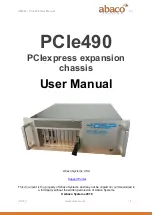
90
Specifications and requirements
•
Site wiring must include an earth ground connection to the DC power source. Grounding must comply
with local, national, or other applicable government codes and regulations.
•
Power circuits and associated circuit breakers must provide sufficient power and overload protection.
Weight and placement guidelines
"Physical requirements" (page 91)
for detailed size and weight specifications.
•
The weight of an enclosure depends on the number and type of modules installed.
•
Ideally, use two people to lift an enclosure. However, one person can safely lift an enclosure if its
weight is reduced by removing the power supply modules and disk drive modules.
•
Do not place enclosures in a vertical position. Always install and operate the enclosures in a
horizontal/level orientation.
•
When installing enclosures in a rack, make sure that any surfaces over which you might move the rack
can support the weight. To prevent accidents when moving equipment, especially on sloped loading
docks and up ramps to raised floors, ensure you have a sufficient number of helpers. Remove obstacles
such as cables and other objects from the floor.
•
To prevent the rack from tipping, and to minimize personnel injury in the event of a seismic occurrence,
securely anchor the rack to a wall or other rigid structure that is attached to both the floor and to the
ceiling of the room.
Electrical guidelines
•
These enclosures work with single-phase power systems having an earth ground connection. To reduce
the risk of electric shock, do not plug an enclosure into any other type of power system. Contact your
facilities manager or a qualified electrician if you are not sure what type of power is supplied to your
building.
•
Enclosures are shipped with a grounding-type (three-wire) power cord. To reduce the risk of electric
shock, always plug the cord into a grounded power outlet.
•
Do not use household extension cords with the enclosures. Not all power cords have the same current
ratings. Household extension cords do not have overload protection and are not meant for use with
computer systems.
Ventilation requirements
"Environmental requirements" (page 92)
for detailed environmental requirements.
•
Do not block or cover ventilation openings at the front and rear of an enclosure. Never place an
enclosure near a radiator or heating vent. Failure to follow these guidelines can cause overheating and
affect the reliability and warranty of your enclosure.
•
Leave a minimum of 15 cm (6 inches) at the front and back of each enclosure to ensure adequate
airflow for cooling. No cooling clearance is required on the sides, top, or bottom of enclosures.
•
Leave enough space in front and in back of an enclosure to allow access to enclosure components for
servicing. Removing a component requires a clearance of at least 37 cm (15 inches) in front of and
behind the enclosure.
Cabling requirements
•
Keep power and interface cables clear of foot traffic. Route cables in locations that protect the cables
from damage.
•
Route interface cables away from motors and other sources of magnetic or radio frequency
interference.
•
Stay within the cable length limitations.
Management host requirements
A local management host with at least one USB Type B port connection is recommended for the initial
installation and configuration of a controller enclosure. After you configure one or both of the controller
Содержание MSA 2040
Страница 8: ...8 Figures ...
Страница 10: ...10 Tables ...
Страница 32: ...32 Installing the enclosures ...
Страница 44: ...44 Connecting hosts ...
Страница 50: ...50 Connecting to the controller CLI port ...
Страница 52: ...52 Basic operation ...
Страница 70: ...70 Troubleshooting ...
Страница 74: ...74 Support and other resources ...
Страница 76: ...76 Documentation feedback ...
Страница 88: ...88 LED descriptions ...
Страница 94: ...94 Electrostatic discharge ...
Страница 100: ...100 Index ...











































